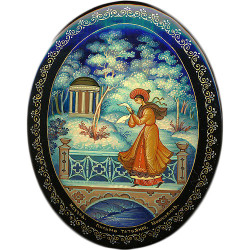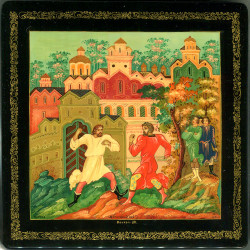No products
Product successfully added to your shopping cart
There are 0 items in your cart. There is 1 item in your cart.
MSTERA
Catalog
New products
-

The Bronze Horseman(Monument to Peter the Great in St.Petersburg), 1965
Arist: Karapaev Yuriy(1936-2009); Size: 9x13.5x5
$425.00 -

The Bronze Horseman(Monument to Peter the Great in St.Petersburg)
Arist: Gordeev V.; Size: 9.5x6.5
$375.00 -

-

-

-

-

-

-

Lel and Snowmaiden
$165.00 $185.00
Each Folk Craft industry is not only a center of unique Art, but a place with it's own peculiar natural features, history way of life and culture. One of such unique centers is Mstera (or Mstyora, how do we call it in Russian).
Village of Mstera located on a rolling banks of Klyazma river in a beautiful scenic spot some 60 miles(100 km) from the old Russian town of Vladimir.
The first information of Mstera as a village of flourishing trade and crafts goes back to the 17th century. Lack of arable land forced its dwellers to practice gardening, crafts and trade. From times of old styles of icon painting, talented needle workers specializing in white satin-stitch embroidery, copper and silver chasers and restorers of icons and frescoes.
In Mstera icon painting came to its final decline at the beginning of the 20th century owing to the emergence of the industrial icon production. Icon painting lost it's significance as an artistic craft. Nevertheless the rich experience, knowledge and skill of Mstera's icon painters did not disappear. Several arduous years went by in search of a new sphere of application for their talents.
1931 was a significant year for Mstera Art.On july 22 an artel was set up that was to specialize in decorating papier-mache objects. It was called "Proletarian Art", a name quite in tune with the times. In a short span of time Mstera's best Masters learned the technique of tempera painting and making papier-mache objects. Yet much remained to be done to bring out all of the aspects of their artistic tradition that could contribute to the emergence of a new art.
The choice of a new style had behind it the joint experience of several generations of artist, but the foundations were laid by Nikolay Klykov,Ivan Serebryakov,Ye.Yurin,I.Morozov, A.Kotyagin,A.Bryagin,I.Fomin and G.Dmitriev.
Making use of all progressive elements of Old Russian culture Mstera's box painting discovered it's own style that was quite different from the kindred crafts of Palekh and Kholui.
Mstera's box is known for the multi-colored ground of it's miniatures painted in light-turquoise and ochre-pink shades. Black is absolutely absent from the color palette. The landscape is painted in a realistic manner. Another typical feature of Mstera's box is the many colored treatment of the trees' foliage that is represented by means of local spots imparting a special decor to the whole miniature. Mstera also offers a more realistic depiction of human figures. It's masters hardly ever use gold to outline the forms-it is found mainly in the ornament.
The vivid works of the founders of Mstera Art have had a favorable influence on the younger artists. In the late 1950's and of course of the 1960's there emerged the Art of a new generation of Msters's Masters--N.Shishakov, M.Dmitrieva, Yekaterina Zonina, Lev Fomichev, Lidiya Demidova, Yuriy Vavanov,A. Krylov, Leonid Zuyikov, Vsevolod Nekosov and Piotr Sosin.
Mstera's lacquer box is vivid evidence of the remarkable viability of old Russian painting and folk decorative Art.
MSTERA There are 67 products.
A letter to Tatiana
This box shows a scene from Pushkin's most famous novel "Yevgeny Onegin". Here we can see Tatyana who is going to send her letter to Yevgeny Onegin. She walks slowly through the winter park, and rereads the letter again and again.
$225.00 $265.00In StockPan-cake Week
This multi-scene cylinder-shaped box was painted by Mstera artist Baburina Svetlana.
$350.00In StockIvan Tsarevich and the Gray Wolf
Khromov Andrey from Mstera is a talented artist responsible for this colorful composition. The coloration captures the eye while the scenery holds each character in a uniquely sentimental way. The artist uses gold paint to accent the composition and make a viewer want to be attracted to it. Every detail is delicately manipulated for a great overall effect!
$550.00In StockFist fight/Boxing
Here we can see a historical scene of two Russian guys having a fist fight or what common known as boxing.
$149.00 $175.00In StockWinter Troyka
This traditional for the lacquer boxes composition was painted in the village of Mstera.
$195.00In StockInstallation:Peacock
Talented artist Strunina Tatiana from the village of Mstera is the author of this installation, consisting of the 3 parts. It shows a scene from the Russian fairy-tale of a Little hump-backed horse, when Magic whale is helping Ivan.
$99.00 $125.00In StockInstallation:Peacock
Talented artist Strunina Tatiana from the village of Mstera is the author of this installation, consisting of the 3 parts. It shows a scene from the Russian fairy-tale of a Little hump-backed horse.
$99.00 $125.00Reduced price!In StockPoem Yevgeniy Onegin after A.S.Pushkin
This semi-antique box was painted by Mstera artist Zimnova.
$450.00In StockEmelya and the magic Pike
This small and pretty composition was painted in the village of Mstera. It shows an episode from the popular Russian fairy-tale "By the Pike's Will" or "Emelya and the Magic Pike".
$125.00 $149.00In StockThe Seven Semeons/Flying Ship
Artist: Molodkin Nikolay; Size: 20x16x4.5; Size (inches): 8x6.25x1.75; School: Mstera
$1,795.00In StockThe Song of Merchant Kalashnikov
Artist: Fomichov Lev Alexandrovich(1932-2018); Size: 15.5x10.5x4.5; Size (inches): 6x4x1.75; School: Mstera
$425.00In StockThe Peasant Lady
Artist: Medvedeva Antonina; Size: 11x6.5x4; Size (inches): 4.25x2.5x1.5; School: Mstera
$175.00In StockPlaying cards
Artist: Tikhomirov Valentin; Size: 10x5x4; Size (inches): 4x2x1.5; School: Mstera
$265.00In StockSnow Queen
Artist: Molodkina Nina; Size: 6x7x11.5; Size (inches): 2.5x2.75x4.5; School: Mstera
$199.00In Stock




















